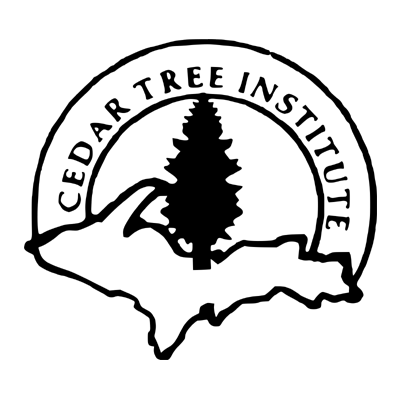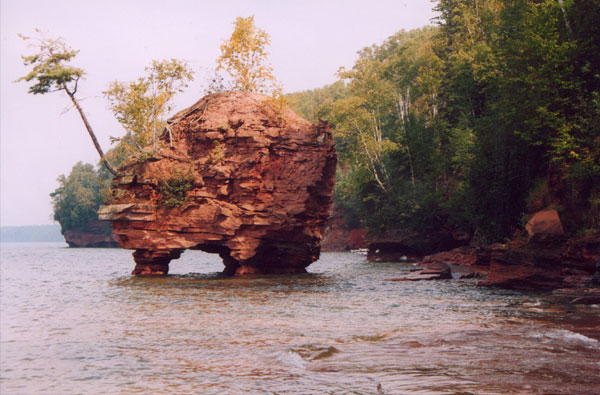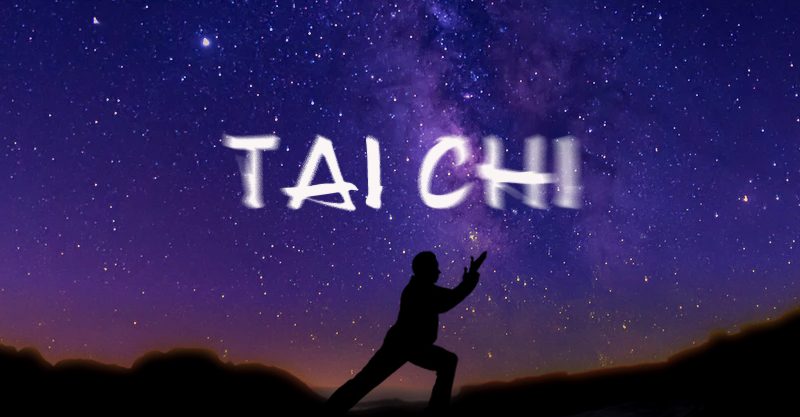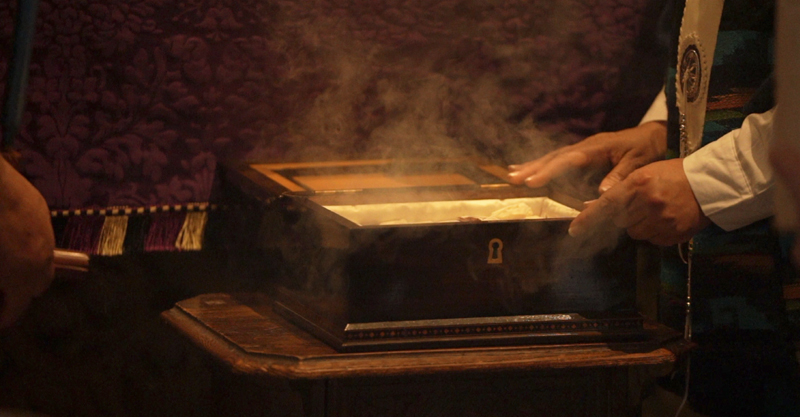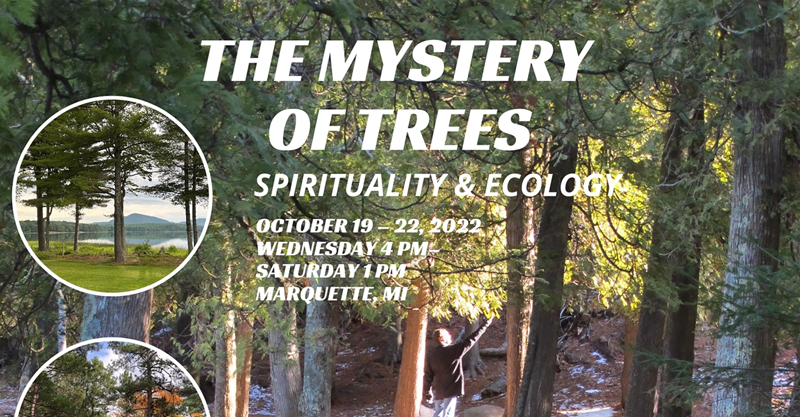from Marquette Monthly December, 2000
An Ode of Praise, Christmas 2000
Oh Ancient One, Full of Mystery and Power
In 1623, a nineteen-year-old Frenchman, dressed in worn moccasins, buckskin shirt and leggings, sat by a candle and oil lamp in the Montreal headquarters of Samuel de Champlain, Provincial Governor of what was then called New France. Earlier that day the young man had arrived, after an extended absence, with a long-awaited report. Because he couldn’t read or write, a scribe sat next to him with ink and feather pen to record his words. For three years Étienne Brulé had been traveling with a band of Huron Indians as a Courier de Bois, a runner of the woods. His mission, commissioned by Champlain, had been to travel west and north to explore a new world shaped by fierce landscapes of forest, rock and formidable winters. It was here, in Montreal, where he came now to tell Champlain of his discovery. It would be a story of his first glimpse of and travels on a lake so large and magnificent no words ever could fully describe it.
Records of their interchange are not detailed, but there’s sufficient evidence that Brulé traveled along our southern shores of Lake Superior during those three years. It’s reported he slept with his Native companions under canoes during rainy summer nights, snowshoed along Superior cliffs in the shadows of the early winter light, and finally reached the farthest southwestern corner of the lake (Duluth), long-time home of the Fond du Lac and Bad River bands of Ojibway Indians.
Centuries later, Lake Superior, first called by the Ojibway Gitchee Gumee and by the French Lac Supérieur, continues to shape the lives of those of us who live on her shores, drink her water, and make our living by her beauty and bounty. Now, four hundred years later, it is we who suddenly find ourselves the uneasy and, in many ways, unprepared stewards of this magnificent natural phenomenon.
Carrier of Legend and Story
A hundred miles north of Sault St. Marie is a small roadside park in Ontario’s Lake Superior Provincial Park. A well-groomed trail leads the visitor down to a series of tall granite cliffs edged by cedar. On the rock face are remnants of pictographs, several of them regarded as hundreds of years old. They are dream images, symbols of the spirit world and markers of journeys, made long ago by ancestors of Native peoples who still identify with some twenty scattered reserves and reservations around the Great Lake. Though currently mired in legal battles and intra-tribal disputes triggered by casino profits and a mangled legacy of devastating government policies, their cultures carry echoes of myth and story that speak to the wisdom of an ancient people. Shortly after our first rough weather in November, Bob Miller, a member of the Fond du Lac Band, reminded me, “When the first snow lies on the ground each winter, we know it’s time for our people to begin telling our stories.”
Barry Lopez, the Oregon writer and naturalist, writes, “Behind every physical landscape, there lies hidden a spiritual landscape.” The power of such spiritual landscapes is carried by story, and Lake Superior is second to none inviting tales of such deeper mysteries. It’s a place where lovers walk hand-in-hand along its shores and children scramble along its rock promenades and sandy coves. It’s a place of memories: of birth, of death, and unforgettable glimpses of nature’s dramatic seasonal changes. The lake’s waters also speak of a thousand fortunes won and lost: of a once booming fur trade now only a dim memory; of a logging industry still thriving; and legends of cold, dark mines long ago sealed and forgotten.
The lake is raising up a new story at the beginning of another Millennium. It is a story of the consequences of human consumption and greed, of complex ecological interactions, of a loss of innocence and the search for a new common vision for the earth. Theologian Thomas Berry calls our time “The Great Turning.” It’s a moment, he warns us, when the global community must move from a technological age to an environmental age if human life is to continue as we know it. In 1992 both Canada and the United States set aside Lake Superior as a demonstration site for the two countries. It is here, they promised, that both nations would seek to protect and remove sources of Lake Superior’s contamination and pollution. They dedicated themselves to restore some semblance of the lake’s original condition in a carefully monitored, sustained balance.
Giver and Taker of Life
Unknown to the causal observer, Lake Superior, in all its foreboding majesty, is a fragile body of water. The largest body, by surface, of fresh water in the world, its clarity and cold purity is directly related to its oligotrophic nature, a condition where algae and plankton are unable to survive in its rocky basin through long winters of frigid water. Fish, accordingly, are not as abundant as the weekend sportsman might believe.
In spite of this precarious condition and current environmental threats, Lake Superior is the only one of the Great Lakes where lake trout still can reproduce naturally. Its waters always have been a benevolent Giver of Life. Lake Michigan, in contrast, has been dramatically altered by industry and unchecked commercial development. Many species of fish in other Great Lakes are now spawned in fish hatcheries.
The turnover of waters in Superior is estimated at 200 years as compared to three years in Lake Erie and eighty in Lake Michigan. This presents a sensitive environment, easily impacted by contamination from toxic chemicals and ballast water emptied into the lake from foreign ships docking in Lake Superior’s international harbors.
For those of us who have grown up on the lake’s shores, there is always gnawing at our deeper awareness a sense of awe and fear of the lake’s power. Sebastian Junger in The Perfect Storm (1997) acknowledges that a key component of that terrifying, peculiar phenomenon occurring in 1992 were the shifting winds and storm patterns that arose that October over the vast surface of the Great Lakes.
In early November I found a seat next to a carpenter friend and Vietnam veteran in Duluth’s packed city auditorium. Gordon Lightfoot, Canadian folk singer, was concluding a season tour on the twenty-fifth anniversary of the greatest disaster on the Great Lakes in the last century. His rendition that night of “The Wreck of the Edmund Fitzgerald,” a haunting folk song that unexpectedly spun him unto a world stage, was note perfect. You could hear a pin drop during his performance. Three rows were cordoned off for special guests, family and relatives of the twenty-nine men who went to their graves on the night of November 10, 1975.
The Fitzgerald, of course, was only one of hundreds of ships that have sunk in the waters of this Great Lake, but Lightfoot’s gifted lyrics and song line have marked the untamed and violent character of Superior in a special way. The wreck of the Edmund Fitzgerald will live on for generations as a sign of Lake Superior’s regal and dangerous power. And of nature’s ultimate triumph over the finest of human invention and ingenuity.
Patient Teacher and Natural Healer
The wife of a friend of mine is an artist who uses nature as her palette and teacher. Her specialty is jewelry crafted small pieces of discarded, worn shard glass from bottles broken among the cliffs and sand. She spends hours searching Lake Superior shores for these treasures. I often think of her walking along the forest and rock beaches, sifting in her hands fragments of washed-up glass shaped by years of Superior’s crashing waves.
The Great Lakes are, first and foremost, connections to the great lessons of time. Carved 10,000 years ago from a retreating ice age, these huge basins are framed by exposed rock ledges of the Pre-Cambrian shield. In these four-billion-year-old rock formations one can glimpse the beginning of time. They will be here long after all of us are gone. They are windows into a creative force so powerful and mysterious that encounters with them invoke a sense of reverence.
Lake Superior is an exquisite, memorable teacher. Intensive research on Great Lakes water quality has confirmed the mysterious and magnificent biological cleansing mechanisms of the natural world. Those who minimize the impact of our unbridled consumptive lifestyles upon the biosphere are, in one sense, correct: Nature has its own cleansing systems. Powerful forces for restoration are built into the “DNA” of the natural world. There is plenty of evidence that the earth will take care of itself.
The dilemma is that this self-correction often takes hundreds, if not thousands, of years, when dealing with synthetic toxic chemicals. In the process, those species that cannot adapt become extinct. During the brutal redemptive processes of the earth’s natural cycles, there’ s no guarantee that the quality of human life as we know it, in spite of our technology, will be able to sustain itself. The World Health Organization now reports that eighty percent of all cancers are environmentally triggered.
Not long ago I traveled to Canada to attend a BiNational Lake Superior Forum Conference on global warming and the impact on the water quality of the Great Lakes. The presenter, a renowned scientist from the University of Minnesota, predicted dramatic changes in Lake Superior over the next fifty years if carbon dioxide in the atmosphere continues to increase at levels similar to the last fifty years. This expected increase is due to continued combustion of fossil fuels (oil, gas, and coal), along with the vast burnings of South American forests that are scheduled to continue, unchecked, in the Amazon.
There is evidence, the researcher suggested, that levels in the lake could decrease as much as three to eleven meters during this period, virtually blocking off Lake Superior’s outlet in the St. Mary’s River on the eastern end of the lake. If that should occur, the clarity of the lake, as we know it, will be lost forever. She reminded us that the natural oxygen in the water is normally continually mixing and evaporation also is minimized with the cover of ice over much of the lake during the winter. With the mixing and ice cover reduced, the pristine clarity of this Great Lake could become a lingering memory that only our generation will remember. It would be similar to the vast pine forests that once covered the Great Lakes Basin in the middle of the 19th century, remembered now only by the generations who came before us.
Leave us Your Wisdom, Grant us Your Mercy
Over the recent years since returning to the shores of Lake Superior to make a home and life here, I’ve made it a point to attend numerous outdoor adventure presentations on canoeing, kayaking, hunting and fishing. The great majority of those events have made me uneasy. They are presentations about gear, techniques and personal heroics.
I have come to believe it is the poet and the artist who, on behalf of us all, finally approach the Great Lake with its deserved reverence and respect. During my first December back in northern Michigan I joined a group of university students and community folk to gather one evening around a family fireplace. We came to listen to Julianne Isabelle, a retired teacher and one of our community’s poets and writers.
On that winter night she spoke of the characteristics of what she called “The Lake People,” and her perceptions of the personality of those who have found themselves living on the shores of Lake Superior. She spoke of those who, through all seasons, walk along our coast, drawn to the horizon, sit in a car along the shoreline during lunchtime or ramble singly along a frozen snow-covered beach. She writes, “In ancient ritual they come / each in his or her generation / to the water’s edge/ instinctually drawn / to know the truths that touch / the heart’s line.”
In the quiet of these December days and nights, watch for those who wander alone along the lake’s edge in the footsteps of the young adventurer Étienne Brulé. Some will be looking for small pieces of worn beach glass, others dreaming of adventures and promises of romance. All search the horizon for the heart’s line.
As the bells of St. Peter Cathedral ring out over our darkened frozen harbor this coming Christmas Eve, Lake Superior cries out for our attention and sacred care, our honor and thanksgiving.
May we, in turn, ask her to continue to teach us her wisdom. And grant us her mercy.
– Jon Magnuson
December 2000
